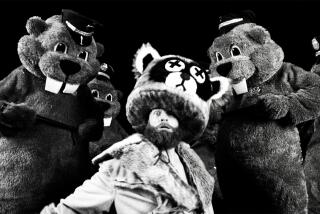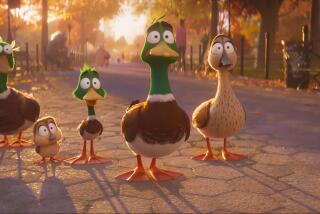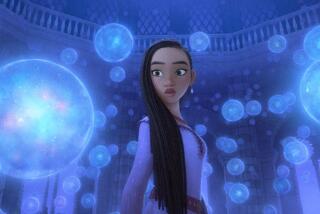Fleet ‘Happy Feet’ taps into issues too
IF there is such a thing as your standard penguin movie, “Happy Feet” isn’t it. But with George Miller involved, how could it be?
The Australian filmmaker, whose credits range from writing and producing “Babe” to writing and directing “Mad Max,” doesn’t make that many films, but those he does tend to be unusual. Which “Happy Feet” certainly is.
A marvelous example of state-of-the art computer animation, “Happy Feet” is part family film, part Antarctic travelogue, part inspired musical (“ ‘March of the Penguins’ meets ‘Riverdance,’ ” to quote voice talent Robin Williams), and, most surprising of all, part ecological fable. The parts don’t always fit together snugly, but most of them are absolutely dazzling.
Though much current animation, from “Open Season” to “Over the Hedge,” features talking animals, nothing even comes close to “Happy Feet’s” strong environmental concerns. This is that rare animated feature that would be right at home on a double bill with “An Inconvenient Truth.”
Yet no one will come out of “Happy Feet” humming an Al Gore position paper. The film’s musical and dancing numbers are little less than inspired, and they come out of a riff Miller and his co-writers John Collee, Judy Morris and Warren Coleman lifted right from nature.
Each emperor penguin, apparently, has a distinctive squawk that enables the birds to distinguish each other in the largest crowds. The penguins in “Happy Feet,” by extension, all have popular songs instead of squawks inside them, songs that represent who they are and serve as mating calls to attract members of the opposite sex.
And what songs they are. To see penguins, by themselves and in groups, singing John Powell’s engaging arrangements of, among many others, the Beatles’ “Golden Slumbers,” the Beach Boys’ “In My Room,” “Leader of the Pack” and “My Way” (in Spanish, no less), is even more of a treat than it sounds.
This only works because the film’s superior voice talent (Elijah Wood, Nicole Kidman, Hugh Jackman, Brittany Murphy, Hugo Weaving and Williams in two roles) combine with advances in computer technology (the lead penguins have as many as 6 million feathers on them) to make these birds seem surprisingly realistic.
Computer technology has also made the on-screen re-creation of the frigidly beautiful Antarctic region -- where the birds go through stunts that would be the envy of X-Games participants -- look as realistic as the 80,000 photographic images the film worked from can make it.
The core plot idea of “Happy Feet” is that one particular penguin is born different. Nicknamed Mumble (voiced by Wood), he can’t sing to save his life, but his feet are truly happy.
To make Mumble’s tap dancing on ice truly impressive, Miller used the same motion capture technology that created Golum in the “Lord of the Rings” trilogy and combined it with the artistry of Savion Glover, today’s master tapper. The results speak (or tap) for themselves.
Though his mother, Norma Jean (Kidman), is supportive of her son’s tapping, Mumble’s father, Memphis (Jackman), is aghast. “It just ain’t penguin,” he laments. This is the position of tribal elder Noah (Weaving), who thinks Mumble’s antics are the reason why the fish supply is dwindling, threatening the penguins’ very existence.
Though the fetching Gloria (Murphy) has eyes for the songless Mumble, he is cast out from the penguin tribe. Which means that he meets the irresistible voice of Williams (always a gift in animation) not once but twice: as Ramon, the leader of the Adelie Amigos, a group of five Latino penguins (don’t ask), and as Lovelace, a penguin guru by way of Barry White.
Mumble has the notion that what the penguins call “aliens,” i.e. humans, are responsible for the declining fish supply, and he determines to do something about it.
No film with as many elements as “Happy Feet” is successful with all of them, and the romantic-emotional elements of this story feel overly familiar. But the music and dancing are fresh and new, and this strong an ecological message has not been seen since Hayao Miyazaki’s “Princess Mononoke.” After everything from “March of the Penguins” to “Madagascar,” you may think you’ve seen enough penguins, but you’ve never seen them like this.
MPAA rating: PG for some mild peril and rude humor. Running time: 1 hour, 38 minutes. In general release.
More to Read
Only good movies
Get the Indie Focus newsletter, Mark Olsen's weekly guide to the world of cinema.
You may occasionally receive promotional content from the Los Angeles Times.











